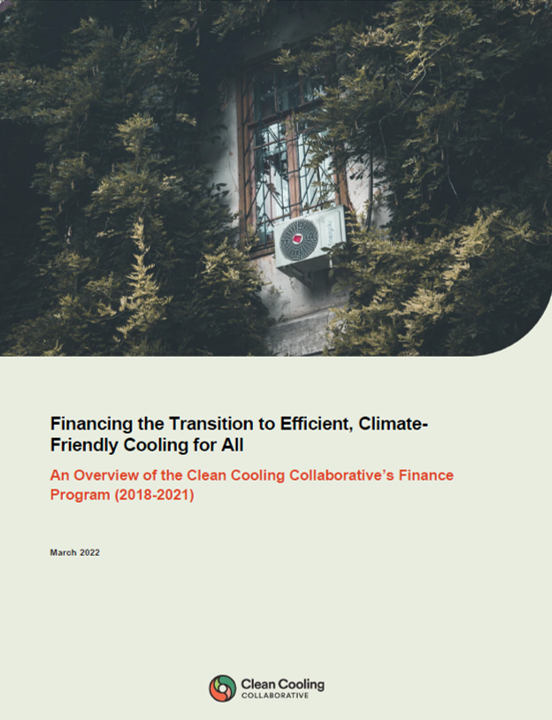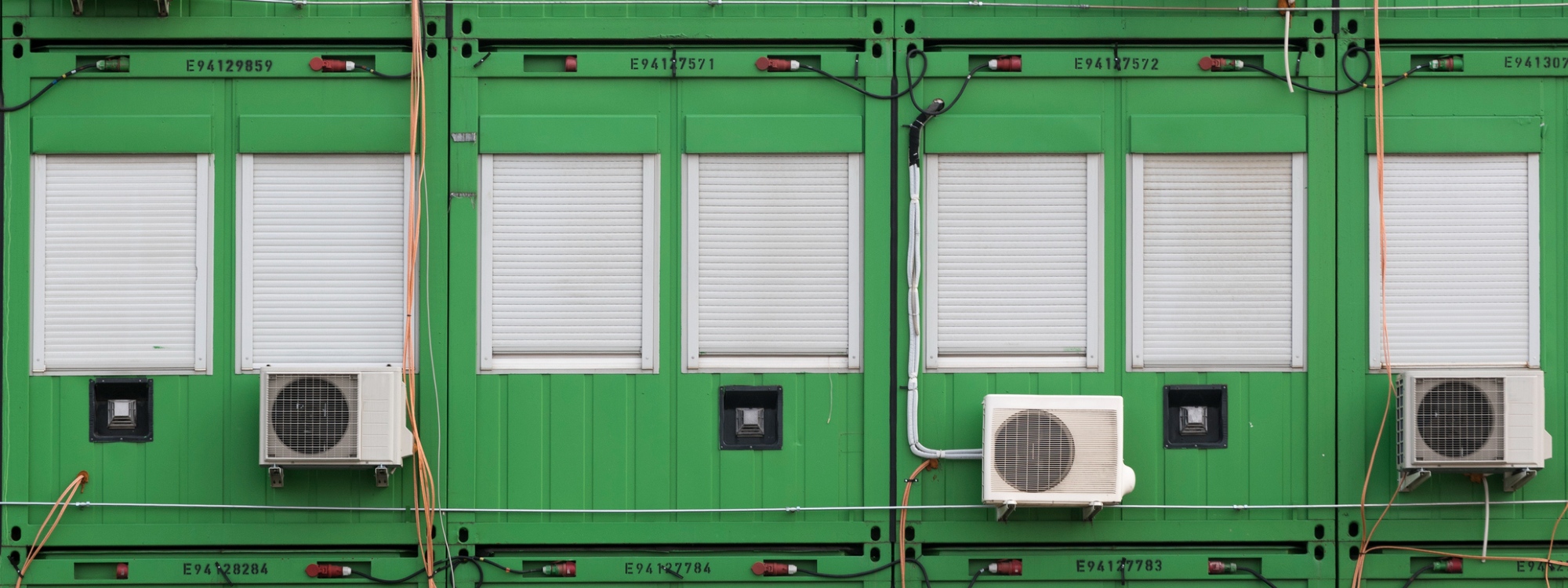Show me the money: Financing the transition to efficient, climate-friendly cooling for all
Show me the money: Financing the transition to efficient, climate-friendly cooling for all
A look back at the Clean Cooling Collaborative’s ‘Finance’ portfolio
During the summer of 2021, it seemed like every week I read a newspaper headline about a new heat wave taking hold in a different part of the world. According to the experts, 2021 wasn’t an anomaly, with extreme heat events set to become a regular occurrence. News like this, in addition to rising global incomes and urbanization rates, is why cooling demand is expected to triple by 2050. Unfortunately, today’s cooling technologies (e.g., air conditioners and refrigerators) consume massive amounts of energy and contain super-polluting greenhouse gases (GHGs) called hydrofluorocarbons (HFCs). Cooling is already responsible for more than 7% of global GHG emissions and the projected rise in cooling demand over the next thirty years is expected to result in a two-fold increase in cooling-related emissions over the same time period.
It’s not a case of simply curtailing demand to cut emissions; access to cooling is vital for sustainable development, particularly relating to health and food systems. As global temperatures rise, we’ll need more cooling to maintain human comfort, health, and productivity, as well as to preserve food and medicines. If we’re to meet global cooling needs without exacerbating the climate crisis then we need to ensure that future cooling solutions are energy efficient and climate friendly. Achieving this is crucial for international agreements like the Paris Agreement, the Kigali Amendment to the Montreal Protocol, and the Sustainable Development Goals.
Money talks
Financing efficient cooling for all will require significant investment. While the total price tag is not yet known, the cost of inaction, as well as potential cost savings, are quite persuasive.
According to the Economist Intelligence Unit (EIU), expanding electricity capacity to meet the growing demand for cooling will cost around US$4.6 trillion over the next decade. And according to the International Labour Organization (ILO), 1.5°C of global warming by 2100 would result in the loss of 2.2% of working hours (or 80 million jobs) by 2030, at an equivalent cost of US$2.4 trillion. These figures are by no means exhaustive and they don’t even begin to factor in other costs like impacts to human health, loss of life, and impacts on food supply, but they should go some way in convincing stakeholders to act.
In terms of what we have to gain by investing in the transition to more efficient cooling, we could reduce the cost of the renewable energy build out by up to US$3.5 trillion by 2030. It could also speed up the transition to net-zero emissions by eight years.
Financing cooling efficiency is a big opportunity, with the super-efficient cooling equipment market estimated to be worth US$135 billion. The EIU estimates that the rising demand for cooling could drive market value to almost US$170bn in 2030.
Unlocking finance for clean cooling
What stands in the way of financing the transition to clean cooling? One major barrier is that there are relatively few examples of financing mechanisms that demonstrate how to support efficient, climate-friendly cooling. If we’re to mobilize the necessary finance at speed and scale, we need demonstration projects across a range of geographies that use different applications and financing mechanisms. Dissemination of lessons learned and best practices is also needed to raise awareness of funding opportunities and to mobilize capital from new investors.
Another issue is the sheer scale of the funding needed. It’s unlikely that any one stakeholder group will be able to support the transition alone. We need collaboration across philanthropy, the public sector, and the private sector to maximize potential impact. As an initiative of a philanthropic organization, we are particularly interested in the role that grantmaking can play in kick-starting the necessary finance.
Since 2018, we’ve issued US$10 million in grant funding for work on cooling finance. As of 2021, we estimate that this money will mobilize an additional US$600 million for initiatives that cost-effectively steer consumers and institutions towards more efficient, climate-friendly cooling solutions.
In addition to the six grants that fall under our finance portfolio, we’ve supported multiple grantees under other portfolios to prepare projects for finance. We’ve partnered with a range of capital providers to pilot innovative approaches to unlock finance for efficient, climate-friendly cooling across different geographies. Our projects have focused on a broad range of applications, including air conditioning and refrigeration across residential, commercial, industrial, and transport sectors, as well as supporting integrated and passive solutions like cold chains and cool roofs. We’ve provided targeted technical assistance grants to mobilize the capital needed to integrate energy efficiency improvements with the transition to low global warming potential (GWP) refrigerants.
Projects have included:
- Supporting innovative consumer financing initiatives to help consumers overcome the higher upfront cost of energy-efficient cooling appliances. We partnered with the United Nations Environment Programme (UNEP) and the Basel Agency for Sustainable Energy (BASE) to develop on-bill and on-wage financing initiative through which customers can purchase an efficient, climate-friendly air conditioner and/or refrigerator1 with finance from a commercial bank. Customers then make repayments via their utility bill or salary deduction. See ECOFRIDGES and R-COOL for more information.
- Promoting green public procurement to help national and local authorities reduce the climate impact of their cooling systems while also stimulating the adoption of clean technologies and providing manufacturers with market certainty. We partnered with GIZ (Germany’s development agency) to develop a public procurement program in Bangladesh and UNEP for a district cooling project in Egypt.
- Catalyzing bank finance to fund clean cooling projects. For example, development banks providing finance to governments for public programs like cold chain development or passive cooling projects, or commercial banks offering finance to private entities like manufacturers to fund production of efficient appliances or developers to fund clean cooling projects.
- Supporting innovative business models like cooling-as-a-service (CaaS) where consumers pay for cooling on a per-unit basis rather than investing in the cooling equipment. The service provider owns, maintains, and covers all operational costs of the cooling system. Through this model, the service provider is incentivized to use the most efficient equipment. Energy Service Companies (ESCOs) provide a similar service with different contractual models that apportion costs between user and provider.
Our finance portfolio has been a lab for action at scale and this work is proof that finance can influence institutions, build on policies and standards, develop supply chains, and raise awareness. We’ve catalyzed action and assisted in the implementation of projects that will result in additional on-the-ground investment in clean cooling, demonstrating how philanthropy can mobilize finance at scale.
More details about these projects, key challenges, and lessons learned can be found in a review of our Phase I finance work and its executive summary, produced in collaboration with the Carbon Trust.
What next?
It’s undeniable that global cooling demand is high and that it’s on the rise. It’s also undeniable that we need to find ways to ensure demand is met with minimal impact to our climate. The above examples demonstrate the viability of different approaches to financing the provision of clean cooling solutions.
So, where next for the Clean Cooling Collaborative? Armed with this success and experience, we’re exploring how to replicate these approaches in different geographies. We’re also looking at how we can integrate finance more holistically across all of our work so that we can build on our strong foundations and amplify philanthropy’s impact.
This blog is part of a series looking back at the impact of our Phase I projects. Other blogs include a review of our policies and standards portfolio, our access portfolio, and our efficiency portfolio.





